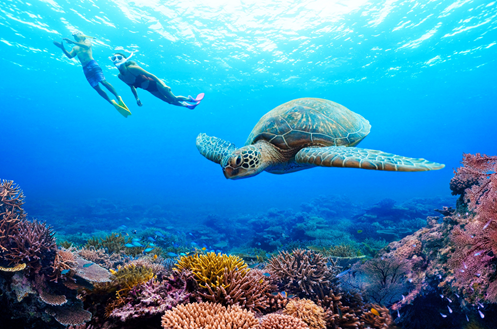Traversing a distance of more than 3,000 kilometres north to south, the island nation of Japan is surrounded by vast tracts of sea, ranging from icy cold currents in the far north, to subtropical waters in the south. With so much water around, it’s only natural that the country should offer exceptional diving. Japanese divers have been exploring the country’s dive sites for decades, but up to now they’ve largely been off the radar of all but the most adventurous international divers. For those looking to discover a diverse underwater playground, Japan cries out to be discovered. Dive right in – there’s plenty to see.
Winter diving in Hokkaido
While most people may associate Hokkaido with skiing in winter, for the hardy few who are not afraid of the cold, the island presents spectacular opportunities for diving. The Shakotan Peninsula is the only place offering boat dives in winter, and while it may be cold, the rewards for those who brave the low temperatures are many. Located on Hokkaido’s west coast, three hours away from Sapporo, you’re likely to encounter unusual marine life on a winter dive here. Giant octopus, Steller sea lions, Okhotsk akta mackerel and lumpsucker fish are just some of the creatures that make these cold waters their home. Diving surrounded by steep snow-covered cliffs is an unforgettable experience.
For those looking for even more of a thrill, the Shiretoko Peninsula in the far northeast of Hokkaido offers a unique experience – drift ice diving. Drift ice starts its journey 1,000 kilometres away, forming on the Amur River on the Russia-China border, floating on top of the denser seawater, and drifting down to the Sea of Okhotsk Sea off the coast of Hokkaido. The temperatures may be freezing, but there are plenty of onsen hot springs to warm up in afterwards.
Encounter hundreds of banded houndsharks in Chiba
Home to Narita International Airport and close to Tokyo, Chiba is the main point of entry for many travellers to Japan. While most just pass through, there are plenty of reasons for divers to spend some time here, including the exciting dive spot in Ito, at the tip of the Boso Peninsula, where you can be surrounded by hundreds of banded houndsharks. This is not diving for beginners – it’s easy to get bumped into by the sharks which, although harmless, can knock divers’ masks and regulators off. Divers without intermediate skills should not embark on this adventure. But for those who have the skills and the confidence, it’s one of the few places in the world where you can dive in such close proximity to this many sharks. Keep an eye out for stingrays too, and if diving in winter, you may be lucky to spot cormorants diving underwater for fish.
Dive in Japan’s first National Marine Park
On Shikoku Island, the smallest of Japan’s main islands, Kochi prefecture’s Pacific-facing coastline is impacted by the Kuroshio Current, one of strongest ocean currents in the world, bringing warm, nutrient-rich waters northwards, creating a rich biodiversity that is sure to delight divers. In the waters off Kochi are corals, tiny creatures such as pygmy seahorses, large schools of amberjack and skipjack tuna, and it’s also possible to see turtles and dolphins.
Tatsukushi, Japan’s first national marine park established in 1970, is home to a number of dive sites with different attractions in each season. Head underwater in winter to discover more than 100 varieties of colourful nudibranchs; dive in late summer and autumn for large schools of fish, including rainbow runners, damselfish and anthias.
Subtropical waters perfect for novice divers
Okinawa, the chain of islands in the far south of Japan, is blessed with warm waters that are a great place for beginner divers. Combined with exceptional clarity and a wide variety of marine life, it’s one of the most loved places for underwater exploration in the country. The 20 islands that make up the Kerama archipelago, 40km to the southwest of the main Okinawa Island, are easily accessible by boat from Naha, the prefecture’s principal city. The journey takes around 35-60 minutes by high-speed boat, but it’s also worth overnighting in Kerama.
Almost 100 dive sites and incredibly clear waters here mean that you’re guaranteed to see plenty, whether you choose to dive deep or merely snorkel on the surface. The Akajima Marine Science Laboratory has recorded 248 species of coral in the waters of Kerama, more than 60% of the total found in Japan.
The conditions here are perfect for beginners with calm waters and mostly gentle currents, and there are plenty of diving curses on offer. But more advanced divers will also be entranced by the opportunities to see manta rays and three species of sea turtles in the clear waters. There are also a number of artificial reefs here, attracting large schools of fish.
Just as Japan is famous for its four seasons above water, the different seasons below water each offer their attractions. For more information of when to dive, where to dive, and what to see, visit JNTO’s dedicated diving website.









